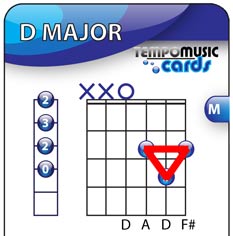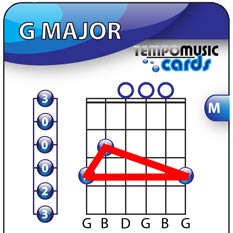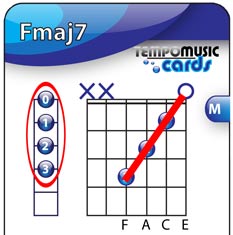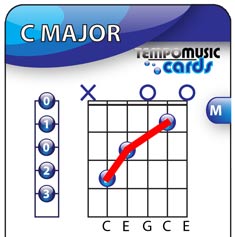Lesson info
This is a very basic lesson with a couple simple techniques you can use to learn chords faster and to memorize them. This is suitable for beginners just starting out learning chords.
It’s recommended that you use the 50 Essential Chords Packs to get the most out of this lesson but you can still learn without it.
The chord learning curve
Most beginners probably feel a little overwhelmed when they find out how many chords there are to learn. When you consider that the 50 Essential Chords Pack on this website contains only the most basic open chords suitable to beginners, it becomes clear that there are hundreds of different chord shapes. While you don’t need to learn that many, even learning 50 chords can be a challenge to a new player. It will take some time for your fingers to learn how to change between the chords and to sit at the right place near the frets. There’s no secret method to skipping the effort involved to memorize the chords but there are a few things we can do to make the whole process a little easier and faster. The idea below is what’s called a mnemonic device, which is a very effective tool you can use to speed up the time it takes for you to memorize chords. It may sound too simple to work but when you get used to it you will be surprised how much faster you learn.
Chord shapes
When you think of the words Circle, Diamond, Triangle and Square do you picture the shapes in your head? Can you clearly see what those shapes look like without any effort at all? The aim of the method below is to try and help you achieve the same thing when thinking of chords. When you think of the chords Am, C, Em or D can you easily picture the chord shapes in your head and imagine where your fingers are placed? What about chords such as Asus2, Gmaj7 or Cadd11? Using the technique below will help you visualize these chords and memorize them easier.
If you have the 50 Essential Chords Pack, pull out the card for D Major. Have a look at the finger positions the chord uses and the way the dots are positioned. You should notice that the three dots on the first three strings make a simple triangle pointing down the neck. In the photo below I marked out this triangle.

Now when you go to play D Major, keep in mind that your fingertips should be forming a triangle shape on the neck. So if you place a finger in the wrong position, it should be obvious because your fingers won’t be in the same shape. It may not sound like much but it has a big impact on how long it takes for you to recall the chord shapes.
For another example take out the chord named G Major. This chord has three finger positions across all six strings. Look at the positions where you need to place your fingers and ‘connect the dots’ to try and see if there is any pattern or shape you can use to help you memorize the chord. You will see it makes another triangle, except this time the triangle is stretched across all six strings as marked out below.

When you compare this shape to other chords it stands out and makes it a great shape to help you remember the chord. The shapes the chords make don’t have to be perfect shapes like the one for D Major, they just have to be distinct to help you memorize the chords. Some chords will have simple shapes that will be easy to memorize and others will have complicated shapes that make it harder to learn. But on every chord make sure you think about the shape and the position your hand is in because it will always help you learn the chord faster and easier.
Number patterns
If you use TAB a lot to learn songs, you will need to get used to picking out the chords in TAB format. The TAB format is another tool you can use to help you learn the chord positions faster. Have a look at the chord Fmaj7 and think about the shape it makes.

It’s clearly a straight line diagonally across the fretboard. It’s a very simple shape to memorize. Now have a look at the TAB diagram to the left of the card and look closely at the fret numbers used. You should notice it makes a very simple pattern when you read from the high e string to the D string – 0 1 2 3. This is an example of using a TAB number pattern to help you memorize the chords.
If you look at a chord and don’t think the shape it makes will help you with its memorization, have a look at the TAB number pattern.
Combining the methods
The best way to memorize the chords is when you combine the two methods of looking at the shape as well as the number pattern. This way your mind has two tools it can use to help you recall a chord. For example, when you look at the chord C Major, the shape is pretty much a straight line with a bend like a hockey stick. That’s a pretty easy shape to remember. Then when you look at the number pattern it reads 0 1 0 2 3 from top to bottom. Not the best number pattern but you can simplify it to 1 2 3. In other words, you start by placing your first finger on the first fret, then the second finger on the second fret and finally the third finger on the third fret – 1 2 3.
Summary
Learning and memorizing chords is a huge step for beginners and using memory tools such as the ones above along with other tools such as the 50 Essential Chords Pack makes the whole process significantly easier. You can still learn the chords without using these memory tools, although it will take longer. There are plenty of other memory tools you can use so whatever you can think of will help out in one way or another.
Click here for more lessons

